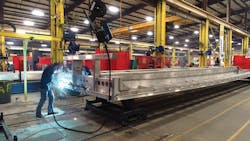Growing trailer backlog challenges manufacturers
The U.S. trailer industry backlog grew 3% sequentially in December, according to ACT Research’s quarterly report on trailer components, but ended 2021 9% below the previous year.
The U.S. New Trailer Components and Materials Forecast from ACT Research aims to provide those in the trailer production supply chain, as well as those who invest in said suppliers and commodities, with forecast quantities of components and raw materials required to support the trailer forecast for the coming five years.
“Overall, last year closed with the U.S. trailer industry facing a backlog-to-build ratio of eight months,” said Frank Maly, director of CV transportation analysis and research at ACT Research. “December was the second consecutive sequential gain. After remaining well over 10 months earlier in the year, backlog-to-build averaged eight months from May through December, an indication of OEMs’ efforts to closely balance their order boards and their potential production levels.”
The report includes near-term quarterly predictions for two years, ACT said, while the latter three years of the forecast are shown in annual details. The analysis is segmented into two categories: the structural composition of new trailers and the production of undercarriage assembly.
“The dry van category closed 2021 with an 8.7-month backlog-to-build, while reefers, normally the category with the industry’s longest backlog, ended 2021 at 8.3 months,” Maly said. “Surprisingly, the long horizons occurred in the vocational categories, with heavy lowbeds currently stretching into early Q2 2023 at current production rates.”
See more from ACT Research: Trailer orders hold firm in January
The industry remains challenged by component and materials issues as well as staffing, although our projections do call for a gradual increase in production rates as the year progresses, Maly explained. “That said, OEMs’ efforts to ramp volume continue to come short of their preferences.”
According to Maly, supply chain issues will continue to slow OEM production increases.
“Frequently mentioned in supply constraint discussions are castings, forgings, wiring, lights, suspensions, axles, wood, and tires,” Maly concluded. “As one contact noted, the challenges are widespread and varied: 'It’s something different every day.'”
About the Author
FleetOwner Staff
Our Editorial Team
Kevin Jones, Editorial Director, Commercial Vehicle Group
Josh Fisher, Editor-in-Chief
Jade Brasher, Senior Editor
Jeremy Wolfe, Editor
Jenna Hume, Digital Editor
Eric Van Egeren, Art Director

